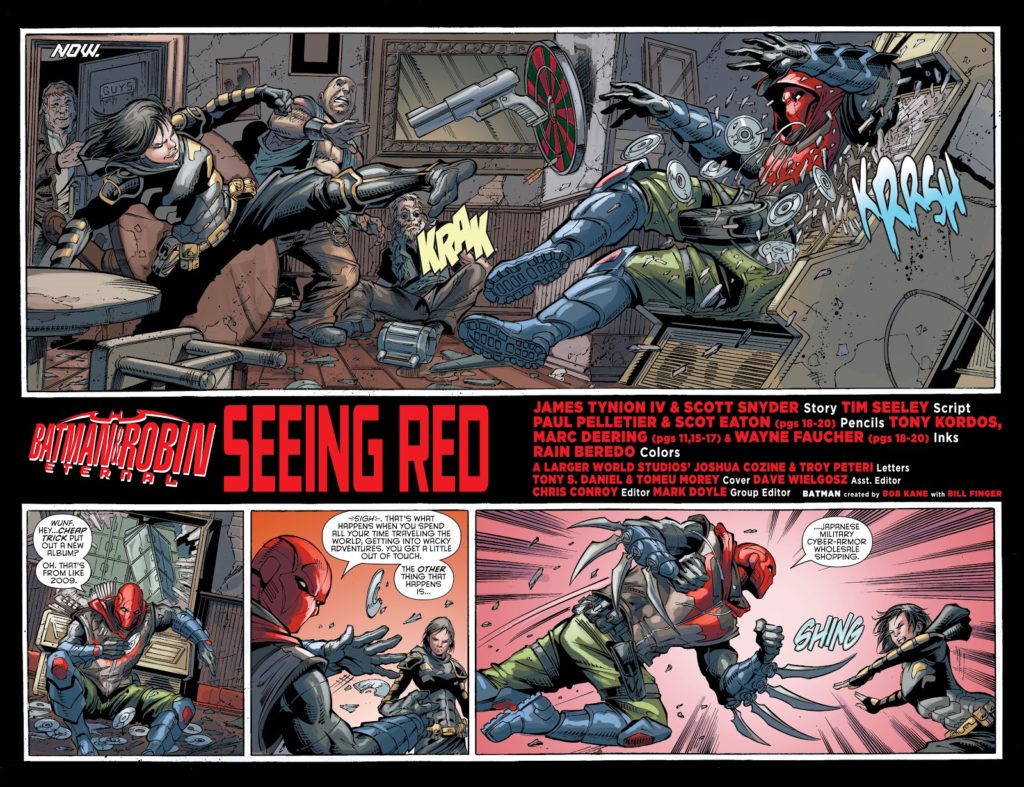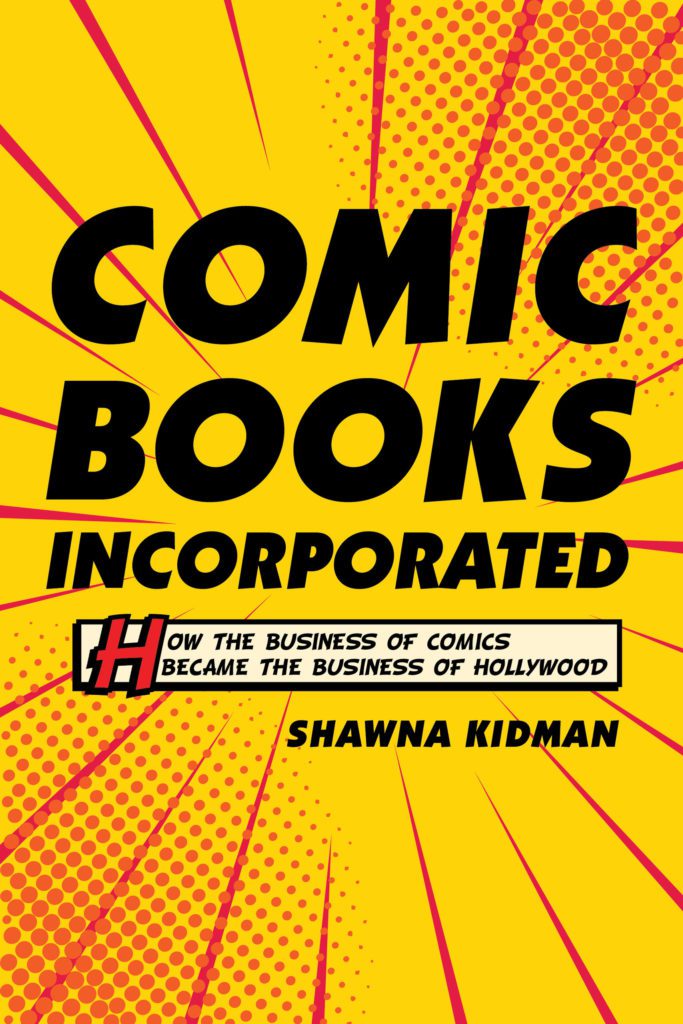Comic Books Incorporated by Shawna Kidman is a book that challenges accepted myths about comic book history and the industry surrounding it. The book’s focus stays away from the artistic merit of comics and, instead, centralizes on the industry infrastructure. This stance somewhat undermines the modern argument that comics have endured because they are a successful Art Form. However, industry, technology, and money (whether corporate or otherwise) have always played an important role in manipulating the art and cultural markets. Modern Artists, such as Tracey Emin and Damien Hurst, are as much business tycoons as they are creatives. The famous painters of the Renaissance period only survived, in the same way, that their artwork has survived to this day, because of the funding behind it coming mainly from the Church and the State. And it wasn’t the decline of creativity that killed off EC Comics or brought about the first Comic Book market crash in the 1950s, as Shawna Kidman demonstrates in her book.
But why have comics become so entrenched in their own mythology and so beholden to stories and histories that only tell part of the greater picture? Everyone knows the story of Batman’s creation and how, for decades, Bob Kane was given all of the credit. It wasn’t until 2015 that Bill Finger started to receive shared recognition in the comics, although his involvement has been part of comics lore for much longer. Situations such as this are rife within the comic industry, with gossip and rumor spreading throughout the community to the point that the tales become fact, obfuscating the truth. In the Batman example, the policy held by DC Comics at the time was that a single artist would receive credit for the story or character irrespective of how many people worked on the actual finished product. Therefore, the industry practice cemented the history that Bob Kane created Batman and was standard practice in the publishing industry. It was only because of a) the ever-growing popularity of the character and b) the obsession from certain fans that anyone cared to look into and argue for Bill Finger’s case. This leads you to wonder how many other creations are not correctly credited and how many artists and writers deserve a larger mention in the history of Comics.

Emerging Communities
One of the problems Comics Studies faces is that much of the history and discourse over the years has been produced by the fans or the creators of the comics. This is especially true in the US marketplace, where the study of comics was frowned upon because it was deemed low culture and not accepted into the halls of academia. As a result, a lot of the writing about the comics industry came from fanzines which were more interested in the comics and creators and less interested in the markets and corporations behind the productions. They also had a particular bias towards superhero comics because the most prominent publishers, Marvel and DC, created the fan bases by controlling much of the distribution and share market.
Aaron Kastan notes in his chapter from Keywords for Comics Studies that the ‘fan community emerged in the 1960s, [.] and is organized around institutions such as comic conventions, comic book stores, and fan magazines.’ (1) As the distribution and sales of comics shrank, the community was stereotyped based on the active members of the fandom, those who went to the conventions, regularly frequented the specialist comic shops, and submitted articles to the underground fanzines. Marvel and DC relied on the continued support of this fandom and began marketing directly to them. Without a larger, diverse audience, what was deemed necessary in the comic industry was dictated by a few members of this community and, in a less direct way, the publishers themselves. In much the same way that the early defenders of comics were employed by the industry (2), the emerging history of comics was being led by fans of superhero comics. ‘The limited body of scholarship on comics fandom tends to assume that normative comics fandom is the primary readership for comics and that this community is mostly straight, white, and male’ (3) explains Kashtan and which became the standard stereotype for comic readers for decades. This culture was brought about and fed by the large publishers who ‘increasingly oriented their products toward a small, essentially subcultural audience, many of whom self-consciously identified as comic book fans.’ (4)

Creating a Niche Market
The creation of the direct market made it even easier to interact directly with fans while at the same time reinforcing a niche market. Benjamin Woo points out that as, ‘an unintended consequence,[.] comic books became increasingly foreign to the everyday experience of most Americans.’ (5) Quoting Jean-Paul Gabillet, Woo continues; ‘comic books were no longer a mass medium, but were a sector of the cultural industry that was increasingly structured around a ‘fan’ audience,’
It wasn’t long before many of the people who pursued a career in comics came from this world of fandom, in essence solidifying the niche culture even further. It is also worth noting that comics studies’ growth came from this fandom. Woo tells us that the ‘history of comic books and the careers of their creators is due to the efforts of the fans who documented it.’ (6) Therefore, the information and knowledge is biased, more often than not, towards the superhero comic and in turn champions specific creators and the comic books that were the favorites of the fandom. Many titles and creators who only had a small following disappeared into the annals of history, barely making a footnote. For example, if Batman had been canceled in the late 1950s, which was a real possibility at the time, then Bill Finger’s involvement would probably not have become the topic of much discussion and research, and Bob Kane would have remained the sole creator linked to the character.

Expanding the Field
Many important aspects of comic book studies, especially when it involves the history of the format, have very little documented scholarship to draw from, and what does exist is usually from a small group of dedicated fans whose main interests lay in their obsession with the comics and not in examining them as cultural objects or works of art. Therefore, it is easier to accept established mythologies surrounding a small collection of comics than it is to take into account the vast multimedia worlds that comics were, and still are, a part of. Shawna Kidman says in her book, ‘Comic books dominate the cultural landscape, and it is worth knowing where they come from, what they mean, and who and what gave them that meaning.’ (7) Without expanding our understanding of the histories surrounding comics, looking beyond the ‘known’ myths, it will become increasingly difficult to understand and accept the current position comics hold in our multimedia world. Narrow-minded approaches to the past will instill narrow-minded views of the present. Still, thanks to books like Comic Books Incorporated, different outlooks are starting to be discovered, shared, and built upon. Many art forms have arrays of books, often contradicting each other, that invite discussions around their histories and cultural status, and I can’t see why such discussions shouldn’t exist within the comics discourse.
References
1 Fawaz/Streeby/Whaley. Keywords For Comics Studies New York University Press 2021 (pg 89)
2 Kidman, Shawna. Comic Books Incorporated University of California Press 2019 (pg 51)
3 Fawaz/Streeby/Whaley. Keywords For Comics Studies New York University Press 2021 (pg 91)
4 Hatfield/Beaty. Comics Studies: A Guidebook Rutgers University Press 2020 (pg 116)
5 Hatfield/Beaty. Comics Studies: A Guidebook Rutgers University Press 2020 (pg 117)
6 Hatfield/Beaty. Comics Studies: A Guidebook Rutgers University Press 2020 (pg 118)
7 Kidman, Shawna. Comic Books Incorporated University of California Press 2019 (pg 45)

